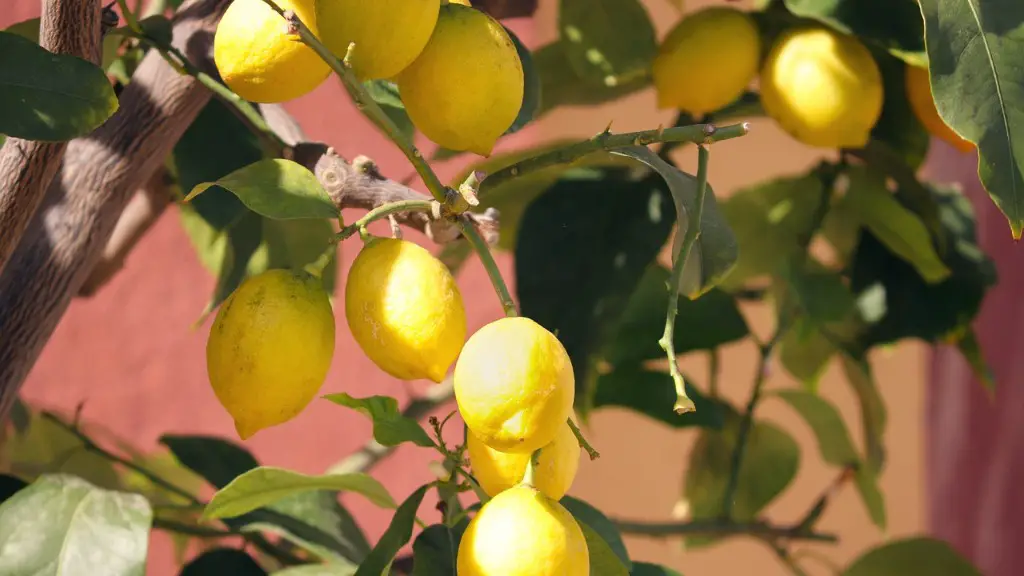Lemon trees thrive with a steady supply of water, but too much can be harmful. Contrarily, not enough water will cause citrus fruits to become misshapen, lack flavor and color, and have thick, bitter skins. Knowing when and how to water your lemon tree can mean the difference between success and failure.
When a young lemon tree is first planted, it should be watered every day for the first several months. Once the tree starts to mature, watering should slow to once per week. During dry or hot spells, it is important to increase the frequency of watering, as well as the amount of water. For a lemon tree to reach its full growth potential, it should receive at least two inches of water per week.
To ensure a healthy lemon tree, water should be applied to the soil until it is saturated, but not to the point of run off. Because lemon trees prefer drier soil to wet, it can be helpful to water in the middle of the day, so that it will be mostly dried up by evening. Over-watering any plant can lead to root rot and other issues, so it’s important to water just enough.
To measure water and soil levels, it is best to use a moisture meter. Inserting a moisture meter into the soil will give an immediate idea of how wet or dry the soil is. The meter works by sending electrical signals through the soil, and these signals give a relative reading of water saturation.
Adding organic matter to the soil can also be beneficial for increasing water absorption and retaining soil moisture. Research shows that adding organic matter, such as compost or mulch, can improve soil water retention and allow plants to take up more water without being over-watered.
Finally, it is important to keep in mind that all plants need different levels of water depending on their age and the climate they are situated in. The best way to ensure your lemon tree is getting enough water is to observe its leaves. If leaves look wilted or discolored, then your tree may not be getting enough water.
Organic Matter
Organic matter added to the soil around a lemon tree helps hold moisture and nutrients for the benefit of the lemon tree. It can also help to increase sustainability of the soil in that it will be better able to retain moisture – reducing water needs and also will help improve soil aeration. This is especially important if the soil tends to become waterlogged. Organic matter, such as compost or mulch is best chosen for the kind of soil that is found in the area where the lemon tree is growing. If possible organic matter should be sprayed with liquid fertilizer before application to provide an additional boost for the lemon tree.
Adequate Nutrition
Adequate nutrition is vital for any type of tree, including lemon trees. The soil surrounding the lemon tree needs to be rich in nitrogen, as well as phosphorus and sulfur for the lemon tree to thrive. Without an adequate supply of these nutrients, the lemon tree will be unable to absorb the proper amount of water needed for growth and fruiting. Proper fertilizer should be applied to ensure that the lemon tree is receiving all the essential nutrients it needs to thrive.
Temperature Regulation
For lemon trees to not only be able to grow but thrive in their environment it is important to regulate the temperature. This is particularly important when temperatures are extreme and it is essential that the tree is protected against frost and heat. It is recommended to provide shade or install a misting system on the tree during periods of extreme heat and to provide shelter in areas where there is a potential for frost.
Proper Soil Structure
Having the proper soil structure is essential for a healthy lemon tree. An ideal soil structure should provide the tree with plenty of drainage, as the tree does not like to stand in soggy soil. Incorporating sand into the topsoil helps to achieve a loose-enough environment for the roots to be able to spread out. In addition to this, the structure of the soil should allow for adequate air circulation to ensure the lemon tree’s roots are able to take in oxygen.
Pruning
Pruning is essential for a lemon tree. It helps to promote balanced growth by removing foliage that is blocking the tree’s access to sunlight and also keeps the tree’s size manageable. Pruning should be done annually, and can often help to add shape and vitality to the tree, improving its overall health. It is important to note that pruning should be done with care, being especially mindful of the lemon tree’s delicate branches. Pruned limbs should be done so as to not leave any jagged edges that could be harmful.
Disease Prevention
Lemon trees are subject to many diseases, some of which can be prevented with proper care. Moisture and humidity can cause fungal diseases, like citrus scab and gummosis, to be transmitted to the tree unless there is proper air circulation. To prevent fungal disease, it is important to keep the area around the tree free of clutter, as well as keeping the humidity under control. Additionally, it is important to keep up with general maintenance tasks, like cutting away dead or diseased limbs, to help keep the tree healthy.
Pest Control
Lemon trees can also be susceptible to pests. The most common ones are aphids and citrus leafminers, but they can also be prone to whiteflies, mealy bugs, and scale insects. The most effective means of pest control is to practice prevention, by making sure the tree is healthy and pruning away any dead or damaged growth. Insecticidal soaps, horticultural oils, and other methods are also effective in controlling pest populations.



